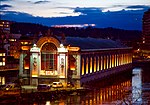Basilica of Our Lady of Geneva

The Basilica of Notre Dame of Geneva is a Roman Catholic church and Minor Basilica located in Geneva, Switzerland. The Basílica enshrines a venerated namesake image of the Blessed Virgin Mary. Pope Pius IX gifted the white Carrara marble statue of the Immaculate Conception, named "Our Lady of Geneva" in 1859. Pope Pius XI granted the image a decree of Pontifical coronation on 26 April 1936. The rite of coronation was executed via the papal nuncio Filippo Bernardini on 23 May 1937. Pope Pius XII issued a pontifical decree which raised the shrine to the status of minor basilica on 4 August 1954. The motto of Our Lady of Geneva is Nuntia pacis, Latin for "Messenger of peace". The shrine is a common stopover for pilgrims going to Santiago de Compostela. The basilica marks somehow the beginning of the "via Gebennensis", which extends from Le Puy-en-Velay in via Podiensis.
Excerpt from the Wikipedia article Basilica of Our Lady of Geneva (License: CC BY-SA 3.0, Authors, Images).Basilica of Our Lady of Geneva
Boulevard James-Fazy, Geneva Grottes et Saint-Gervais
Geographical coordinates (GPS) Address External links Nearby Places Show on map
Geographical coordinates (GPS)
| Latitude | Longitude |
|---|---|
| N 46.208611111111 ° | E 6.1419444444444 ° |
Address
Église Notre-Dame
Boulevard James-Fazy
1201 Geneva, Grottes et Saint-Gervais
Geneva, Switzerland
Open on Google Maps








